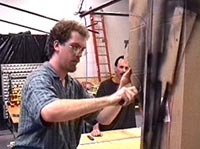
Animator! Animator!
Written by Amy Souza | Posted by: Anonymous
Wreckless Abandon Studios is a sibling-owned and -operated animation production company in East Granby, CT. With brothers Mark and Michael Bannon and their sister, Linda Bannon-Hannan, at the helm, the company specializes in clay animation, stop-motion production, and 3D computer animation. NewEnglandFilm’s Amy Souza discussed with co-owner and creative director Michael Bannon the life of an animator, and the love of the craft.
AS: Describe a "typical" day at Wreckless Abandon.
BANNON: Well, there is no such thing as a typical day at Wreckless Abandon. One of the aspects that I enjoy the most about the animation process, and clay animation in particular, is that it demands such a variety of expertise in so many diverse art forms.
A random day starts at about 9:00 a.m. Our studio has several departments. There are the business and production offices, storyboard rooms, character modeling and sculpting shops, and a workshop for armature and set construction. I’ll usually meet with John Loos, my director of photography, and the production manager, Leslie Haber, and we’ll discuss any adjustments or revisions to the schedule for that day, along with the ongoing preparations for that week’s upcoming shots. Next I’ll make the rounds, giving art direction to the head sculptor, Stacey Karragiannis, in the sculpture shop. Then it’s onto the workshop to oversee the production of sets and set elements necessary for the upcoming production schedule.
AS: What are the biggest challenges you face in your work? Are they different from the challenges faced by those working in live action?
BANNON: In any production, a million things have to go exactly right to end up with a great piece of work. If just one thing goes wrong, it can ruin the shot. This is particularly true of stop-frame animation because it is so labor-intensive and can take days to do a shot that is just a few seconds long, as compared with live action, where you can just do dozens of takes in a row, once you are set up. This makes pre-production all the more important in animation. Also, in live action, you can find actors and locations which exist. In stop-frame animation, you have to create the actors and the sets from scratch.
AS: How would you describe what you do to someone who knows nothing about the business if you had just a few minutes to explain it?
BANNON: We are faced with the impossible task of bringing inanimate things to life. We take basic materials like clay, wood, wire, metal, plaster, and paint and transform them into beautiful moving emulations of life and fantasy by applying finely honed skills and monumental effort under unifying direction. Our field involves all of the complexities of live-action production, such as writing, directing, casting, storyboarding, lighting, shooting, editing, art direction, audio production, scoring, etc., along with the complexities of having to sculpt the characters and sets all to scale. Also, an animator has to be an actor and director as well as a sculptor. These are a lot of diverse skills to demand of one individual, but that’s what it takes.
AS: What do you like best about your work?
BANNON: The people that I get to work with. I’m the luckiest guy in the world! I get to work with a team of extremely talented artists, and we all love what we do. On many nights, I have to kick them out in the wee hours of the morning because we know how fortunate we are to be working together at such a high level of aesthetic. The whole is greater than the sum of its parts, and despite all of the long hours and hard work, when you see it come together and we watch the end result come to life on the screen, it is magical, and none of us would trade places with anyone on Earth!
AS: What work are you proudest of and why?
BANNON: Well, I love the half-hour special that we are producing for the Mohegan Indian tribe because it is such a fabulous story, and the imagery is very rich. I’m also proud of a piece that we produced for LEGO Systems, Inc. It’s an 18-minute video for preschoolers I wrote and directed. It is always a pleasure to be writer and director as it allows you to complete a project without compromising the vision, and the end product maintains the integrity of the writing. We’re also currently working on some spots for Sony Music that are a lot of fun.
AS: Where do you see the animation business going in the next ten years?
BANNON: With ever-expanding demands and mandates for cable, broadcast, the Web, and home video, I know that the demand for programming–particularly quality programming–will only increase. The technical formats will change (broadband, HDTV, DVD, etc.), but the demand for exceptional production design skills will always be a commodity. In the sea of programming that inundates people on a daily basis, animation will be in increasing demand in the future because animation embodies such a high level of aesthetic. When done right, it is pure art, and true art is classic, timeless, and will always be in demand.
AS: What would you say to those interested in a career in animation, whether as animators or producers?
BANNON: Personally, I would say that it requires more dedication than any other profession, so if you aren’t willing to sacrifice–and I mean in a big way!–don’t bother. If you still want to, because a true animator will only listen to the little voice inside their head, you should focus on art and aesthetics. Get a liberal arts background. Become a thinker. There are lots of technophiles and specialists out there, and technical skills are important, but one can learn to push the right buttons in no time. It’s learning the right time to push those buttons that takes years. Develop great 2D and 3D design skills. Most animation is a complex combination of reasonably fundamental artistic skills. Learn how to write, act, draw, sculpt, paint, dance, observe. Study photography, anatomy, theater, art history, math, science, mechanical engineering. Develop people skills, business skills, communication skills, negotiating graphics skills, computer skills, and electrical skills. Everything on Earth can become pertinent as animation, particularly clay animation, involves all of the disciplines of live action with the additional complexities of miniaturized sets, lighting, and camerawork. Finally, if you desire a career in animation, get a degree in psychology so that you can save money on having your head examined, as it is definitely a labor of love!
For more information about Wreckless Abandon Studios, visit the Web site at www.wrecklessabandon.com, or you can contact Mark Bannon at 860-844-7090, or email him at mab@wrecklessabandon.com.












